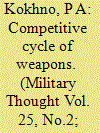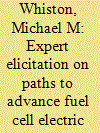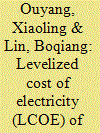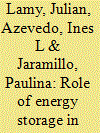|
|
|
Sort Order |
|
|
|
Items / Page
|
|
|
|
|
|
|
| Srl | Item |
| 1 |
ID:
085825


|
|
|
|
|
| Publication |
2008.
|
| Summary/Abstract |
In march 2008, parliament voted to extent Canadian military operations in Afghanistan through 2011. By July of that year, roughly 41000 Canadians will have served in the Afghan theatre of operations, 15000 more than fought in Korea.
|
|
|
|
|
|
|
|
|
|
|
|
|
|
|
|
| 2 |
ID:
147798


|
|
|
|
|
| Summary/Abstract |
The author studies the arms life cycle within his theory of the competitive cycle, i.e. its economic efficiency from production of items according to their intended purpose and further utilization. The author proves the necessity of application of methods to assess the full cost of arms supplied to the troops.
|
|
|
|
|
|
|
|
|
|
|
|
|
|
|
|
| 3 |
ID:
125734


|
|
|
|
|
| Publication |
2013.
|
| Summary/Abstract |
Current UK Government support for nuclear power has in part been informed by cost estimates that suggest that electricity from new nuclear power stations will be competitive with alternative low carbon generation options. The evidence and analysis presented in this paper suggests that the capital cost estimates for nuclear power that are being used to inform these projections rely on costs escalating over the pre-construction and construction phase of the new build programme at a level significantly below those that have been experienced by past US and European programmes. This paper applies observed construction time and cost escalation rates to the published estimates of capital costs for new nuclear plant in the UK and calculates the potential impact on levelised cost per unit of electricity produced. The results suggest that levelised cost may turn out to be significantly higher than expected which in turn has important implications for policy, both in general terms of the potential costs to consumers and more specifically for negotiations around the level of policy support and contractual arrangements offered to individual projects through the proposed contract for difference strike price.
|
|
|
|
|
|
|
|
|
|
|
|
|
|
|
|
| 4 |
ID:
111387


|
|
|
|
|
| Publication |
2012.
|
| Summary/Abstract |
Offshore wind power is anticipated to make a major contribution to the UK's renewable energy targets but, contrary to expectations, costs have risen dramatically in recent years. This paper considers the context of these cost increases, and describes a disaggregated levelised cost model used by the authors to explore the effect of different assumptions about the direction and scale of the major cost drivers. The paper identifies the competing upward and downward pressures on costs in the medium term, and discusses the range of future costs that emerges from the analysis. The paper goes on to analyse the implications of these cost projections for the policy support levels that offshore wind may require. The paper suggests that there are good reasons why it is reasonable to expect a gradual fall in costs in the period to the mid-2020s, although it is unlikely that costs will fall as rapidly as they have risen, or that it will be a smooth downward trajectory. A key challenge is to reconcile the scale and pace of development desired for UK offshore wind with the potential growth rate that the supply chain can sustain without creating upward pressure on costs.
|
|
|
|
|
|
|
|
|
|
|
|
|
|
|
|
| 5 |
ID:
183038


|
|
|
|
|
| Summary/Abstract |
While fuel cell electric vehicles (FCEVs) fueled by hydrogen produced using low-carbon processes could considerably reduce carbon emissions from transportation, FCEVs are produced at low volume, are expensive to manufacture, and lack widespread refueling infrastructure. To inform advancement pathways for FCEVs, we conducted an expert elicitation on vehicle costs and performance at anticipated production volumes, governmental actions to advance FCEVs, anticipated sales of FCEVs equipped with an automated driving system (ADS), and anticipated infrastructure deployments. Between 2020 and 2035, experts assessed a three-fold decline in fuel cell system costs to $60/kW and over an order of magnitude increase in production volume to 225,000 systems/year. Levelized costs of driving were assesed at $0.25–$0.90/mile and $0.17–$0.65/mile in 2035 and 2050, respectively. FCEVs could constitute a considerable share of ADS-equipped vehicle sales depending on cost and performance trajectories of automated driving technology and electric vehicles. Experts identified regulatory and incentive-based policies as important governmental actions to advance FCEVs and recommended hydrogen, fuel cells, and technology deployment activities each receive at least 20% of government research and development funding. Medians of experts' U.S. refueling station deployment assessments were 500 and 2,000 stations cumulative in 2030 and 2040, respectively. The middle 50% of respondents anticipated 2030 cumulative FCEV deployments in China of 100,000–1 million.
|
|
|
|
|
|
|
|
|
|
|
|
|
|
|
|
| 6 |
ID:
132748


|
|
|
|
|
| Publication |
2014.
|
| Summary/Abstract |
The development and utilization of renewable energy (RE), a strategic choice for energy structural adjustment, is an important measure of carbon emissions reduction in China. High cost is a main restriction element for large-scale development of RE, and accurate cost estimation of renewable power generation is urgently necessary. This is the first systemic study on the levelized cost of electricity (LCOE) of RE in China. Results indicate that feed-in-tariff (FIT) of RE should be improved and dynamically adjusted based on the LCOE to provide a better support of the development of RE. The current FIT in China can only cover the LCOE of wind (onshore) and solar photovoltaic energy (PV) at a discount rate of 5%. Subsidies to renewables-based electricity generation, except biomass energy, still need to be increased at higher discount rates. Main conclusions are drawn as follows: (1) Government policy should focus on solving the financing problem of RE projects because fixed capital investment exerts considerable influence over the LCOE; and (2) the problem of high cost could be solved by providing subsidies in the short term and more importantly, by reforming electricity price in the mid-and long-term to make the RE competitive.
|
|
|
|
|
|
|
|
|
|
|
|
|
|
|
|
| 7 |
ID:
128407


|
|
|
|
|
| Publication |
2014.
|
| Summary/Abstract |
With an increase in China's oil imports, China's oil supply will also continue to be effected by the socio-economic stability of oil-exporting countries and the safety of oil transport routes. This paper introduces a systematic and quantitative method to evaluate the influence of China's oil import risks (OIR) on the national economy and industrial sectors from a perspective of apply chain process. For this analysis, China's OIR is quantified by integrating oil exporting country risk and the risks from oil transportation routes. Country risk is defined as the oil-exporting country's political risk caused by political changes or internal conflicts. Transport risk is defined as the risk of shipping routes affected by pirate attacks and geopolitics. Second, the relationship between China's OIR and oil import costs is analyzed using a multiple linear approach. Third, an input-output analysis method is used to research the effect of the cost of China's oil imports on the cost of investment within China's domestic sectors. This research finds that the corresponding impact on GDP is 3494.5 million dollars given an increasing by 10% of China's OIR. And the impact on domestic sectors differs from sector to sector. Finally, this paper puts forth recommendations to improve long-term oil supply security in China.
|
|
|
|
|
|
|
|
|
|
|
|
|
|
|
|
| 8 |
ID:
133079


|
|
|
|
|
| Publication |
2014.
|
| Summary/Abstract |
Replacing current generation with wind energy would help reduce the emissions associated with fossil fuel electricity generation. However, integrating wind into the electricity grid is not without cost. Wind power output is highly variable and average capacity factors from wind farms are often much lower than conventional generators. Further, the best wind resources with highest capacity factors are often located far away from load centers and accessing them therefore requires transmission investments. Energy storage capacity could be an alternative to some of the required transmission investment, thereby reducing capital costs for accessing remote wind farms. This work focuses on the trade-offs between energy storage and transmission. In a case study of a 200 MW wind farm in North Dakota to deliver power to Illinois, we estimate the size of transmission and energy storage capacity that yields the lowest average cost of generating and delivering electricity ($/MW h) from this farm. We find that transmission costs must be at least $600/MW-km and energy storage must cost at most $100/kW h in order for this application of energy storage to be economical.
|
|
|
|
|
|
|
|
|
|
|
|
|
|
|
|
| 9 |
ID:
110422


|
|
|
|
|
| Publication |
2011.
|
| Summary/Abstract |
This article identifies the combined value that solar electric power plants deliver to utilities' rate payers and society's tax payers. Benefits that are relevant to utilities and their rate payers include traditional, measures of energy and capacity. Benefits that are tangible to tax payers include environmental, fuel price mitigation, outage risk protection, and long-term economic growth components. Results for the state of New York suggest that solar electric installations deliver between 15 and 40 ¢/kWh to ratepayers and tax payers. These results provide economic justification for the existence of payment structures (often referred to as incentives) that transfer value from those who benefit from solar electric generation to those who invest in solar electric generation.
|
|
|
|
|
|
|
|
|
|
|
|
|
|
|
|
| 10 |
ID:
087160


|
|
|
|
|
| Publication |
2009.
|
| Summary/Abstract |
This article explores the costs assiciated with terrorism, examining the costs of production for terrorist groups and the loss to societies through attacks and defense security spending. Unlike previous military conflicts, terrorism entails a destinct defender disadvantage: small amounts of money and manpower can inflict large amount of damage on target society.
|
|
|
|
|
|
|
|
|
|
|
|
|
|
|
|
| 11 |
ID:
041137


|
|
|
|
|
| Publication |
Massachusetts, Addison Wesley Publishing Company, 1971.
|
| Description |
vii, 232p.Hbk
|
|
|
|
|
|
|
|
|
|
|
|
Copies: C:1/I:0,R:0,Q:0
Circulation
| Accession# | Call# | Current Location | Status | Policy | Location |
| 008126 | 658.013/HEL 008126 | Main | On Shelf | General | |
|
|
|
|
|
|
|
|
|